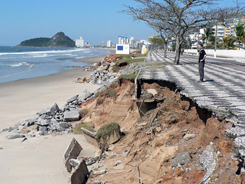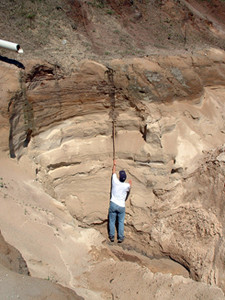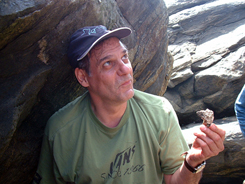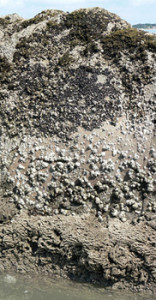3rd International Conference, Brazil, 2006 – Conference Report

3rd International Conference, Brazil, 2006 – Conference Report
IGCP Project 495
PP11: Paleotsunami Research
The Third International Conference and Field Trip of the International Geoscience Programme #495
Quaternary Land-Ocean Interactions: Driving Mechanisms & Coastal Responses
Balneário Camboriú, Santa Catarina, Brazil
16th – 22nd September, 2006
- Field Trip Guidebook of Paraná Coast (.pdf file)
- Field Trip Guidebook of Santa Catarina Coast (.pdf file)
- Program Schedule & Book of Abstracts (.pdf file)
Conference Report

International Geoscience Programme (IGCP) Project 495 seeks to improve our understanding of Quaternary land-ocean interactions, with a particular focus on the driving mechanisms responsible for lateral and vertical changes in sea-level over a range of spatial and temporal scales. The project runs from 2004 to 2009 and, having held its first two international meetings in Maine (2004) and Indonesia (2005), converged on the coastal city of Balneário Camboriú, some 400km south of Sao Paulo, for its third conference and field meeting.
The conference organisers, Dr Rodolfo Angulo and Dr Maria Cristina de Souza (Universidade Federal do Paraná) and Dr Antônio Klein (Universidade do Vale do Itajaí) are to be congratulated on all their efforts in welcoming over 30 colleagues from around the world to Brazil for two days’ of academic papers followed by a three-day field trip to the spectacular coasts of Santa Catarina and Paraná.
The scientific paper session opened with two excellent overview papers of the Brazilian coast bays, estuaries and coastal barriers by Dr Guilherme Lessa and Dr Rodolfo Angulo. The coast of Brazil, like many others in the low latitudes, has experienced a fall in relative sea-level (RSL) since a mid-Holocene highstand. This quite modest fall in RSL, always less than about 3 – 4m, resulted in major changes in coastal geomorphology and processes, most notably colossal coastal progradation with estuaries contracting in size and coastal barriers developing.

Three papers followed that addressed late Holocene coastal change in Belgium (Cecile Baeteman), the Holocene infilling of Algarve estuaries in Portugal (Thomaz Boski) and evidence for 20th century sea-level acceleration based on a meticulous analysis of a New Zealand saltmarsh (Roland Gehrels). The related themes of vertical changes in RSL and lateral shifts in shoreline position continued to be addressed by Vanessa Heyvaert who outlined a new model for the development of the Mesopotamian marshes (Iran) driven by progradation of the Karun-mega fan during the late Holocene.
The impacts of the mid Holocene deceleration in global RSL change had profound impacts of wetland development throughout the World and Ben Horton proposed a warmly debated hypothesis that linked these changes in wetland dynamics and the associated increase in coastal margin productivity with the emergence of civilisations. The final two papers of the day tackled a further set of driving mechanisms for coastal change. Philip Lane presented an impressive palaeoarchive of New England hurricanes obtained from coastal pond sediments based on grain size and geochemical data, a theme returned to later in the conference by Jon Woodruff. Finally, Antony Long detailed the first RSL curve from the south east coast of Greenland and explored the implications of this record for the interpretation of recently collected mass balance data by the Gravity and Climate Change Experiment (GRACE).
Following a delicious conference dinner in a local restaurant, day two of the scientific papers opened with a panoramic overview of the geomorphology of the Brazilian coastal barriers by Sérgio Dillenburg. Discussion here, as in day one of the meeting, included consideration of the source of the abundant volume of sediment that must have been available throughout much of the Holocene to nourish these large coastal landforms and their associated back-barrier infills. Moving to a more northern theme, Arto Miettinen then presented a careful review of the late Holocene RSL history from the south west coast of Finland based on isolation basins. Arto identified evidence for differential uplift perhaps associated with tectonic movements, a theme touched on previously by the Guilherme Lessa in his review of the Brazilian coastal bays.

The development of quantitative reconstructions of RSL change based on transfer functions has been a theme of the last two international meetings of IGCP 495. This approach provides a potentially powerful means of defining continuous records of RSL change based on the statistical relationships between contemporary microfossil assemblages and their fossil counterparts. Roland Gehrels had already demonstrated the potential of such an approach in his reconstruction of a New Zealand saltmarsh RSL record on day one of the meeting and two further papers also used this approach. The first, by Sarah Woodroffe, used a foraminiferal-based transfer function to reconstruct late Holocene RSL records from north Queensland, Australia. The second, by Katie Szkornik, tackled the late Holocene evolution of Ho Bugt in Denmark using diatoms as the preferred microfossil group. Each of the authors advocated caution in the use of the transfer function approach, perhaps more so than in previous IGCP meetings, yet nevertheless demonstrated the power of the method when judiciously applied in combination with careful consideration of litho and chronostratigraphic data. The final paper of the day returned to the theme of hurricane reconstruction, and Jon Woodruff presented a wonderful overview of his research into the overwash and RSL histories of several coastal ponds in the West Indies. Despite the challenges of collecting sediments from these settings, Jon provided fascinating evidence for significant changes in hurricane frequency and magnitude during the late Holocene, especially after about 1000AD.
A poster session allowed delegates to listen to brief project summaries that addressed a variety of IGCP 495 themes. I was particularly impressed by two posters by Brazilian colleagues, one that reported preliminary research concerning the submerged beachrocks of southern Brazil (Fernando Veiga) and a second on some spectacular late Pleistocene (presumed MOI Stage 5e) coastal barrier stratigraphies exposed at Paraná, southern Brazil (José Branco), which we were to later visit in the field trip.

The first day of the field trip focused on the Tijucas coastal plain and the Piçarras beach and Pleistocene barrier, both located to the south of the conference venue. The extensive Holocene coastal plains of Santa Catarina and Paraná are locally backed by late Pleistocene barrier deposits of presumed MOI Stage 5e, although their exact age is yet to be determined. We began our visit to the rain-drenched Tijucas lowlands by standing atop a narrow fringe of Pleistocene barrier that abuts the coastal hills, some 3 m or so above the younger, Holocene shorelines. Duncan FitzGerald led much of the day and demonstrated the enormous potential of ground penetrating radar (GPR) in mapping the internal structures of the Pleistocene and Holocene beaches in Brazil. Duncan had previously shown the ability of GPR to identify the internal bedding geometry of beach facies, as well as erosional layers marked by heavy mineral concentrations on the IGCP495 Maine field meeting in 2004. The results here were equally impressive and the 20km of GPR profiles collected to date have the potential to yield very high resolution (perhaps even annual) records of coastal progradation and storm activity.
From the Pleistocene barrier we embarked on a transects across the Tijucas coastal plain, traversing a variety of back-barrier mangrove, sandy beach and chenier deposits before finally reaching the present coastline. The present beach is remarkable for its thin veneer of muddy sediments that drape the shoreface sands, which owe their origin to the high near-shore suspended sediment concentrations sourced by the Tijucas river. Discussion focussed on the source of the sediment for the Tijucas coastal plain and on the driving mechanism(s) for the change to a more mud-dominated system in the late Holocene.

The second stop of the day was to a small pocket beach at Taquaras (Laranjeiras) where, in contrast to the large, open drift cell of Tijucas, only a narrow coastal plain exists. The steep and reflective beach profile here is sculptured by well-developed beach cusps and survives on the internal recycling of sediment within the headland embayment. The rain was beginning to let-up by lunchtime, but our hopes of an overview of the Balneário Camboriú beach from the top of a cable car were dashed by low cloud, reminding us that there is a sound climatic reason for the presence of the extensive “Mata Atlântica” rain forests that mantle so much of the landscape here. Undaunted we paused for lunch on an airy look-out tower and speculated on the invisible geomorphology several hundred meters below us!
Back at sea-level we stopped at the southern end of the Balneário Camboriú beach to hear of the disastrous attempts to replenish the beach with locally dredged sediment from the adjacent Camboriú river. In 2002, nearly 50,000m3 of sediment were deposited along 800m of the beach and, whilst the scheme was approved by the Santa Catarina State, the project lacked any environmental impact assessment. The result was predictable with extensive ecotoxicological pollution and large accumulations of shell hash on the replenished beach. The beach grain size became coarser whilst there was a significant increase in deposition of silt and clay onto the continental shelf. The problems of beach erosion on this highly developed and rapidly expanding coast continue.
Travelling north we climbed to an excellent viewing point at Cruz Hill, overlooking Itajaí city. Duncan FitzGerald presented further GPR and stratigraphic observations from the large Navegantes strandplain, contrasting the depositional history of this system with that of the coarser-grained Tijucas strandplain visited that morning. One hypothesis for the contrast in grain size between the two is that the coarser sediment from the Navegantes river may be deposited within the river mouth instead of across the adjacent beaches. The penultimate stop of the day was to visit a narrow deposit of MOI Stage 5e beach deposits at Piçarras in the north coast of Santa Catarina state, before continuing on to the delightful coastal city of Guaratuba. Shortly before reaching our hotel our coach pulled off the road at Saí-Guaçu next to a 10m high, heavily vegetated mound which on closer inspection proved to be a huge shell-midden comprised mainly of Anomalocardia brasiliana and Ostrea sp. shells. Shells from the surface of the midden date from about five thousand years ago, close to the time of the mid Holocene sea-level highstand. Shell middens like the Saí-Guaçu example are numerous in Brazil and well over one thousand are known to exist. The middens have been used by some authors in efforts to reconstruct RSL but most now agree that they have little value for such reconstructions but rather more significance as indicators of prehistoric activity, including burial practices and territory demarcation.
One day two of the field trip we continued our northward tour, crossing by ferry the mouth of the Guaratuba estuary and viewing the extensive ebb tidal delta that has developed at the mouth of this, and other estuaries, along this section of the Brazilian coast. They sheer scale of the landforms daunted most of the non-Brazilian delegates used to working on much smaller depositional complexes. Our next stop was in the Paranaguá coastal plain where we were to remain for the rest of the field trip. We began with a visit to a large sand quarry which provided spectacular exposures of the Pleistocene barrier facies at the inner part of the estuary complex. The deposits here comprised well-sorted, medium and fine quartzose sand, as well as heavy minerals, silt and clay. In composition they are significantly coarser than their Holocene counterparts, presumably reflecting a greater fluvial input to these early barrier systems. The Holocene barrier deposits began prograding after c. 4 – 5 thousand years ago, after the highstand had been reached. Indeed, radiocarbon dates suggest that the Paranaguá barrier prograded 3.5km in the last 2000 years with a fall in RSL of about 2m.
By now a consistent pattern of coastal evolution was beginning to emerge, with the infilling of the Paranaguá, Guaratuba and Tijucas all following a broadly similar pattern. During the rising limb of RSL in the early to mid Holocene, large volumes of sediment were transported into the tidal basins and the systems infilled. Uninterrupted longshore drift along the Santa Catarina and Paraná coasts was precluded by the numerous large tidal inlets and by the net transport of sediment into these systems by flood-dominated tidal channels. However, as RSL began to fall from its highstand so the estuaries infilled and a switch occurred from flood to ebb-dominance and large ebb tidal deltas formed. The infilling of the embayments provided the conditions for the establishment of a large south to north drift system that steadily depleted sediment from coasts to the south of Santa Catarina state, nourishing the prograding beach systems in the north.
At the coastal port of Paranaguá we transferred from the coach to a small boat that took us on a sun-drenched two-hour trip to the Ilha do Mel, an island positioned at the mouth of the Baía de Paranaguá. Porpoises kept us company as we motored gently past the mangroves of the outer estuary, whilst a barbeque lunch on the back of the boat provided welcome sustenance. Once on the Ilha do Mel we trecked across the sand tracks that criss-cross this small island to a secluded set of beach apartments overlooking the Atlantic Ocean. A climb to the lighthouse on the Morro do Farol das Conchas provided a stunning panorama of the Baía de Paranaguá, including its vast ebb tidal deltas delimited by pounding surf.
After a comfortable night listening only to the sound of the waves, and with not a street-light in view or car engine in ear-shot, we spent the final morning of the trip exploring the rock coast of the Praia do Farol in search of vermetid remains. Living specimens of these gastropods recently disappeared from this part of the Brazilian coast for an unknown reason, but their fossilised remains, hidden in crevasses beneath large blocks bedrock, provide powerful constraints on former Holocene sea-levels. Rodolfo Angulo has used these indicators extensively in RSL research and adeptly scrambled beneath rocks of various sizes to extract samples for delegates to view. Now thoroughly sun-burnt, we headed back to the boat that returned us to the mainland before driving up the coastal mountains of the Serra do Mar via the Graciosa road, which provided stunning views across the rainforest, before continuing to the city of Curitiba where the meeting ended and colleagues dispersed.
I know that I speak on behalf of all the delegates who attended this meeting in thanking the conference organisers, Rodolfo Angulo, Antônio Klein and Cristina de Souza and their able support team (especially Thammy Barreto and Niamh McElherron (Durham University, UK) for providing such an interesting an enjoyable field meeting. In the spirit of IGCP meetings, they effortlessly combined excellent science with a relaxed and informal atmosphere that means all of us will remember the spectacular coastlines of Santa Catarina and Paraná for many years to come.
Further information on IGCP495 “Quaternary Land-Ocean Interactions: Driving Mechanisms and Coastal Responses” can be found from the UK National Correspondent: Dr Roland Gehrels (University of Plymouth, e-mail: [email protected])
Professor Antony Long
Department of Geography
Durham University
Science Site
South Road
Durham DH1 3LE
e-mail: [email protected]